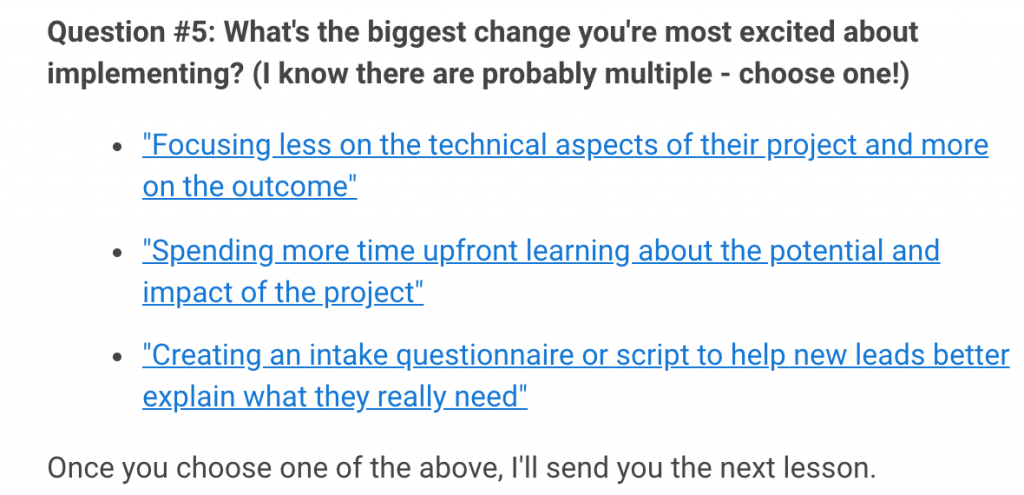When you think of the types of content used in content marketing, what do you think of?
Blogs? Infographics? Videos? White papers? Case studies?
These are great tools in your content marketing toolbox. But one type of content languishes, perennially underappreciated by content marketers:
Online surveys.
Surprised?
Surveys should be a core part of your content marketing process.
If you use them well, you’ll be lightyears ahead of your competition. Let’s take a look at how you can use online surveys to bolster your content operations.
1. Getting details on your buyer personas
Effective content marketing is driven by your audience. What information do they need? Which content formats do they prefer? Where do they go when they need help?
All of this information is represented in buyer personas.
If you’re not using buyer personas, you’re missing out on a valuable resource for content generation. But marketers who use buyer personas often fall into a different trap: the trap of assuming they know their customers.
No matter how well you think you know your target audience, you probably have some misconceptions.
You might be surprised by where they read articles, for example. Or what their hobbies are. Their favorite social networks. Competing priorities in their lives.
You’re dealing with real, unique people, and they don’t fit into a mold.
Surveying your customers gets you get real data. That’s invaluable for content marketers. When you know the problems your readers need to solve, where they go for that information, and how you can best present it, your content marketing takes off.
Few marketers take the time to do real-world research on their audience. Which is a shame, because it’s not only valuable—it’s also really easy.
You can create an online survey in a few minutes and send it to your email list, a few selected customers, or anyone else who might be able to give you insight into your buyer personas.
It’s a no-brainer.
2. Understanding your audience’s specific content needs
Buyer personas give you guidelines on the types of problems you should address and the general types of content to use.
But smart content marketers dive deeper than that. Your audience isn’t made up of buyer personas—it’s made up of people. And those people are looking to solve specific problems.
Addressing those specific problems with your content builds a dedicated audience.
Let’s take a look at an example of how you might start addressing those problems by gathering data with a survey. Brennan Dunn has an email course that helps freelancers earn more money.
At the end of each email, he asks the reader a question:

It only takes readers a couple seconds to answer. But it gives Dunn a wealth of information about his audience.
He can use the answers to these questions to create content that meets the specific needs of multiple groups of readers—even if his subscribers represent a single persona.
Regularly surveying your audience can help you react to changes, too. As your audience matures, it will change, and that may mean different interests. Occasional surveys will help make sure you’re always providing what your readers need.
Just like with buyer personas, you might think you know what your audience needs. But when it’s so easy to survey them and find out, why take the chance?
3. Segmenting your audience
Most businesses need three or fewer buyer personas. But you’re dealing with a complicated customer base.
Audience segments help you better understand those people.
Segments are traditionally used in email marketing. And email is an important part of content marketing. But segmentation is useful beyond your email campaigns.
Look back at Brennan Dunn’s email above. He asked his audience what their biggest problems were.
He might use that to inform his knowledge of who he’s writing to. But he could also be using it to create distinct groups that he can send different email series to.
You can segment other types of content, too. Neil Patel gives some great examples in his article on dynamic content.
Segmenting your users based on survey data might help you serve better pop-ups, lead magnets, or call-to-action buttons. With the right tools, you can turn your survey data into a powerful source of dynamic content generation.
Even if you start with something small, like creating a second email list, you’ll see returns right away.
4. Collecting information for unique data
Few things attract more links and social shares than unique data. Sites like the Content Marketing Institute have used original research to build their authority and create a very strong brand:

In many cases, their research reports are based on survey results. They have a large list of subscribers and a great social presence, so when they send out a survey, they get a lot of data.
No matter how many subscribers you have, you can use surveys for the same purpose. Reach out to your email list, your social followers, your professional contacts, and anyone else who might have insight into a particular issue.
Once you’ve collected responses with your survey tool, you can analyze and present it. Even if it’s not a huge amount of data, the main selling point is that it’s unique—no one else has come up with those same insights.
And, as Michele Linn points out in “How to Plan a Year’s Worth of Content With One Original Research Survey”, you can get a lot out of a single online survey.
You can create articles, downloadable PDFs, SlideShare presentations, videos, and all sorts of other content from that data. A full year of content is no joke.
It takes a lot of work to design and administer a survey that gives you enough information for that level of content. But even if you start small, you’ll still have unique data.
Make surveys part of your content marketing
Understanding your audience is a core part of successful content marketing. If you don’t have a clear, detailed view of who you’re writing for, the chances that you’re writing what they want to read take a serious nosedive.
And that’s where surveys come in. You can use surveys to better understand your buyer personas, segment your audience into smaller groups, and figure out what kind of content they need.
You can use that information—or an entirely new survey—to generate unique data that they’ll value, too.
Online surveys are simple tools that can have big effects. And if you’re looking to run an effective content marketing operation, you need as many of those as you can get.



